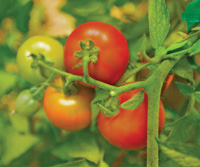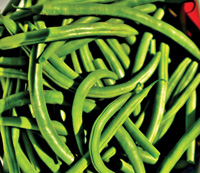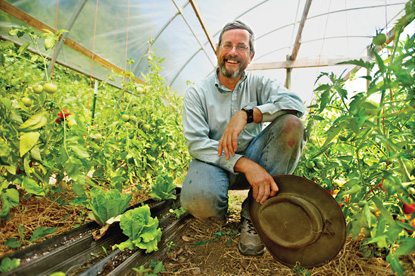The past few decades have seen an explosion of imported, perishable food—apples from China, kiwi from New Zealand, grapes from Chile and many other foods from faraway lands. But recently, the pendulum has been swinging the other way. You might say that food is trying to become more like politics—with all the important stuff being local.
Avocados don’t grow in Aberdeen, nor mangoes in Minneapolis, but what does grow in the Ninth District is increasingly sought by consumers, and growers are responding with new, expanded methods for delivering locally grown produce and other foods to customers.
One fast-growing piece of the local-food movement is community supported agriculture (CSA), where local farmers grow, harvest and often deliver fresh produce and other foods to members who buy annual “shares” in the operation’s output. Not so long ago, growing your own food and sharing it with neighbors seemed to be the province of rural communes and backyard gardens. But available data and sundry anecdotes suggest that CSAs in some areas are drawing more members than farmers can handle.
Phil Hannay, with his wife, Kathy Kubal, have operated Trumpeter Swan Farm in Buffalo, Minn., for eight years. In their second year as a CSA, they filled their subscription quota and turned down other requests. Hannay is seen here in a high tunnel, which extends the growing season by a couple of months. (Photography by Marc Norberg)
Redesigned model
The local-food trend has a lot of green shoots. Probably the most visible is the rising number of farmers markets throughout the district (see the September 2008 fedgazette). But other outlets have developed to expand the frequency of local food reaching your dinner plate because consumers are demanding it. Packaged Facts, a market research firm, reported that consumer demand for locally grown products hit nearly $5 billion in 2007 “and could rise to as much as $7 billion a year by 2012.”
That’s why supermarkets and even Wal-Mart tout seasonal, locally grown produce. Trendy restaurants often list the sources of the food on their menus, and distribution networks are sprouting up to channel locally grown and raised products to retail and institutional markets. According to the National Restaurant Association’s 2009 industry forecast, chefs reported that use of local produce is the biggest trend. The association’s research showed that nine of every 10 fine-dining establishments already serve locally sourced items, and they expect continued growth. The association also found that about three of 10 fast-food businesses serve locally sourced items now, and nearly half of the respondents believe these items will continue to grow more popular.
Government has also been trying to encourage the trend in locally grown foods. The state of Wisconsin provided $225,000 in grants last year to seven projects, including a 200-member farm produce co-op to expand sales through a partnership with the Institutional Food Market Coalition of Dane County and a program to connect restaurants and food service operations with local farmers. The goal of the program is to increase local-food sales, with the implied purpose of expanding the state’s economy. And if the state had $3 million more to share, there were 87 other applicants standing in line.
But the local-food trend doesn’t get any more grass-roots—literally and figuratively—than in the hundreds of CSAs popping up across the Ninth District. A fairly young movement, CSAs were introduced in the United States in the mid-1980s, brought to Massachusetts originally by a Swiss farmer inspired by similar operations in other countries. The basic idea of a CSA is to create a consistent market for farmers and a consistent supply of fresh produce for consumers.
Here’s the way it works. The farmer sells “shares” in farm products, guaranteeing weekly delivery of a variety of items over the growing season; in the Ninth District that usually means from April through October. Generally, farmers offer a mix of products, though if one crop fails and another is overly abundant, shareholder members could end up with lots of squash and meager offerings of other produce for the week’s delivery. But that’s the idea; the community bears the natural risks associated with farming.
A share will typically run from $300 to $700, with some farms selling half shares. A share gives the member about a bushel basket of produce each week. The cost of shares depends on the farmer’s operational costs and other variables like the length of growing season, selection of crops grown and what the soil can bear.
Erin Barnett, director of Local Harvest, a national CSA support network, said that CSAs provide a measure of economic security for farmers, who, by marketing their crops to subscribers during the off-season, develop a known customer base for those crops before they’re planted. Barnett said CSAs are a big part of making small-scale farming viable in the 21st century.
Data farming
Data and other research on CSAs are not particularly robust, which means that gauging the size and spread of the CSA movement can be tricky. CSA operators and suppliers to farmers markets and other food outlets typically operate smaller farms; many of them adhere to organic growing guidelines and supplement their income with other employment.
In a 2002 survey of Upper Midwest CSA operators, the Leopold Center for Sustainable Agriculture at Iowa State University found that the typical CSA farmer in the region (including Michigan, Minnesota, North Dakota and Wisconsin) was 45 years old, had 14 years of farming experience and was likely to be a college graduate. Half the respondents had an off-farm job, but also farmed at least 20 percent of the time. The 2007 Census of Agriculture also shows growth in small farm operations—a reversal of a decades-long trend—many of them run by part-time farmers with other jobs. (See the May 2009 fedgazette for more on the 2007 Census.)

Nancy Welty, owner of Culinary Delights Farm in Big Lake, Minn., fits the Leopold Center’s profile. She is in her third year of full-time CSA farming after 25 years of working in corporate finance. Welty sells 100 shares each year at $550 a full share or $375 a half share and offers 15 pickup sites to her members, many of whom are her husband’s co-workers at a suburban Twin Cities company. She, like most CSA farmers, also has an agreement with subscribers that they share in any crop failure. She grows her produce using sustainable methods and said she needs to educate members that as a result they may not get the big, picture-perfect produce found in grocery stores, but the flavors will be fuller.
Jonda Crosby, executive director of the Alternative Energy Resources Organization (AERO) in Helena, Mont., said there’s been “a huge influx of under-35 farmers flooding to the land.” Anecdotal evidence suggests that many younger farmers are often choosing a local-food approach, including CSAs.
But the number and growth trajectory of CSAs are difficult to pin down. For starters, CSA numbers are fluid, with farmers going to the CSA model if they have enough subscribers or choosing to market their products another way if the subscription process doesn’t work for them. According to a report by the Leopold Center, 30 percent to 40 percent member attrition each year is not unusual, as many members decide that the volume and variety of produce is more than they need. That means farmers might be in and out of a CSA from year to year.
Figures from a variety of sources vary quite significantly. For example, the 2007 Census of Agriculture reports about 12,500 CSA farms, but that includes all farms producing for a CSA program, since some CSAs might involve multiple farms.
The numbers offered by national directories and state groups are somewhat smaller. For example, the U.S. Department of Agriculture (USDA) Marketing Service estimates that CSAs grew from just 60 operations in 1990 to approximately 1,150 operations by early 2007. Numbers tracked by national groups connected to the CSA movement are closer to those of the Marketing Service and also confirm that upward trend.
Local Harvest’s CSA directory grew from 374 listings at the end of 2000 to 1,046 by 2005, according to Barnett. By the end of last year, the directory had 2,128 listings.
Chris Mayer, program manager at the Robyn Van En Center, a national resource center for CSAs, said that its CSA directory has grown by 13 percent since 2006.
In the Ninth District, numbers vary. Wisconsin and Minnesota show the most CSAs in the Local Harvest directory at 137 and 84, respectively. In the Twin Cities area alone, the number of CSAs grew from 32 to 43 in the past year, according to Brian De Vore, spokesperson for the Land Stewardship Project in Minnesota.
But listing in any directory is voluntary, and many CSAs find subscribers via word-of-mouth and through community advertising. That’s probably why there are 14 Montana CSAs listed in Local Harvest, while Crosby put the number at somewhere between 40 and 50. And according to Crosby, that’s still not enough to satisfy the demand. She said that CSAs in Montana generally have waiting lists for subscribers. North and South Dakota both list fewer than 10 CSAs, but the real numbers are likely higher, particularly given agriculture’s presence in both states.
While CSAs have grown mostly around metro areas, Terry Vanderpol, who directs community-based food systems in Montevideo, Minn., for the Land Stewardship Project, said they are moving increasingly to rural areas. She noted two near Montevideo that sell local shares. One couple built a solar greenhouse and offers winter crops of greens and broccoli.
And it’s not just individuals operating CSA farms. Mayer from the Van En Center said the center often receives calls from municipalities interested in leasing vacant city properties to CSA operators; others want to use land trusts and other similar land sitting idle.
A fork in the road
The growing CSA movement is likely both a driver and a benefactor of a broader push for locally grown foods. In addition to homes, supermarkets and restaurants clamoring for local-food products, hospitals, schools and company cafeterias throughout the district are expressing greater interest in using locally grown items. And to do so, new business and distribution models—even legislation—are often needed to allow institutions to change their purchasing methods so that contract food vendors and local-food producers can operate side by side.
For example, it’s typically very difficult for small growers to sell to institutions because food purchase contracts with large vendors often limit outside purchases, said James Barnham, an economist with the USDA’s Marketing Services Division. But he added that more state policies are making it easier for school districts and other institutions to buy local produce.
Montana’s Crosby was part of a group supporting local-food markets that developed legislation to change food procurement laws to allow state institutions to purchase Montana-grown and raised products, even if the seller doesn’t have the lowest bid. The law, now in effect, allows the institutions to pay more for local products as long as they stay within budget.

Public institutions in Montana purchase about $33 million worth of food annually, Crosby said, and prior to the new law only 6 percent (about $2 million) of the products came from Montana farms and ranches. The University of Montana was one of the first vendors to take advantage of the new law and has bought $3 million worth of Montana products for its cafeteria system, up from $100,000 in 2004. Montana State University started its program three years ago and now purchases 15 percent of its food from Montana. According to Crosby, buyers have also discovered that while they may pay more for products initially, they are getting better quality, such as leaner meat, and products have a longer shelf life because they arrive fresh.
A number of Minnesota colleges buy local when they can. St. Olaf College and Carleton College in Northfield and the University of Minnesota campus in Morris, in the southwestern part of the state, all look for local products, said JoAnne Berkenkamp, program director for local foods at the Institute for Agriculture and Trade Policy (IATP), a research and advocacy group in Minneapolis. Since 2003, the Morris campus, for example, has replaced national wholesale purchases to the extent possible with locally grown foods. By 2009, those local purchases could reach $500,000.
The National Farm to School program, a nonprofit organization dedicated to connecting local farm producers with school districts, is active in 41 states and about 8,850 schools. All district states are enrolled, except North and South Dakota. Minnesota has the highest participation rate in the district with 130 schools, including the Minneapolis and St. Paul school districts. Although the Dakotas aren’t involved with the national program, some schools do work local products into their food services. For example, in Fargo and Grand Forks, N.D., school gardens supply produce to some schools, with the help of 4H and Future Farmers activities.
Edward Christensen is the assistant supervisor of food and nutrition services for the Missoula, Mont., public school system, which includes 12 elementary and four high schools and is a member of the Farm to School program. Schools began touting local products in 2005 with meal events, using Montana-grown beef, cheeses, carrots and honey, for example. Christensen said the biggest challenge is that with 3,200 children to feed daily, guaranteeing volumes of local products is hard. “I want to purchase as much as I can here,” he said. Christensen has been putting money where his locally grown mouth is: The volume purchased by food service rose from about 18,000 pounds in the 2006-07 school year to about 45,000 pounds in the 2008-09 school year. Christensen also said he’d like to see the USDA loosen its rules around entitlement program dollars to allow schools to purchase local commodities.
Food deserts; oases needed
But for all the hoopla around growing local products and creating healthier communities, the movement continues to face obstacles, particularly in the Catch-22 of consumers recognizing the benefits of fresh produce and needing wider market access to such goods. AERO’s Crosby, for example, described parts of Montana as a “food desert”—rural areas that don’t have easy access to much more than convenience stores loaded with processed foods. These areas offer opportunities for small farmers and CSAs.
Minnesota’s Vanderpol echoed Crosby’s concern. She lives in a town with one stoplight and needs to go 30 miles to find fresh produce and meats. “It’s a food desert with a direct impact on public health for those who don’t have access to fresh produce and healthy foods,” Vanderpol said.
So while there are some bumps in the locally grown road, the movement continues to expand, and farmers in the district can benefit. “We’re still trying to see the bad news in this. We’ve got fresher [food] and a higher flavor profile,” Missoula’s Christensen said.
Joe Mahon is a Minneapolis Fed regional outreach director. Joe’s primary responsibilities involve tracking several sectors of the Ninth District economy, including agriculture, manufacturing, energy, and mining.







